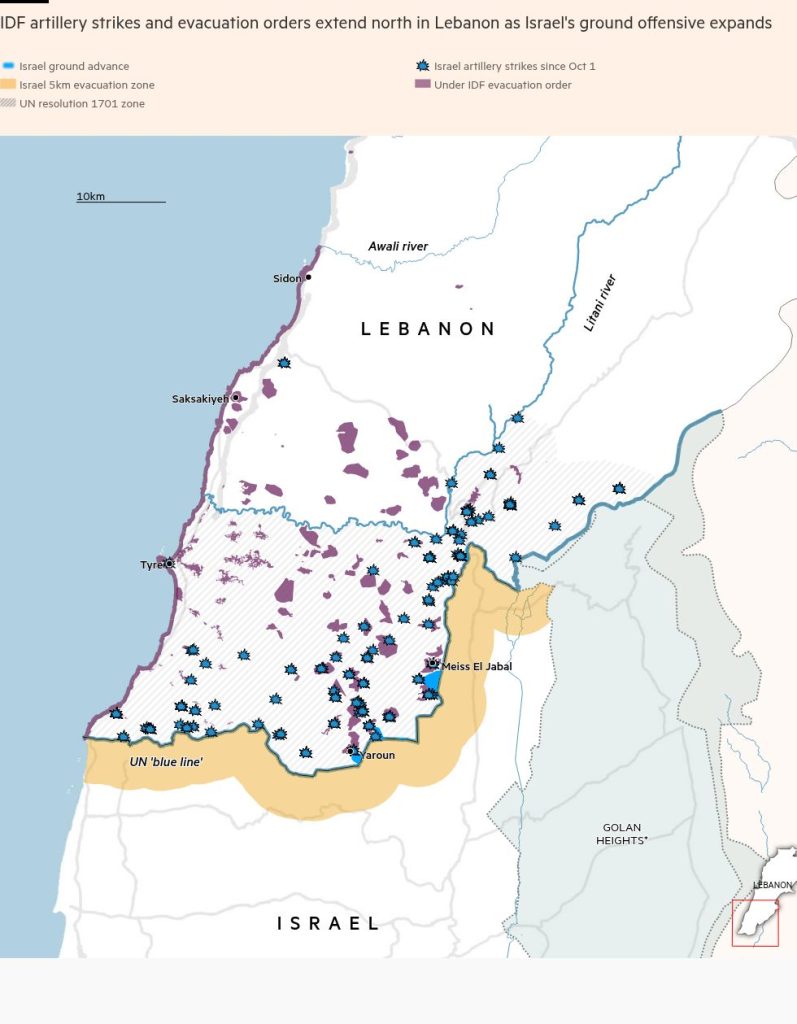Israel and Hizbollah clash near Lebanese border as air strikes escalate

Unlock the Editor’s Digest for free
Roula Khalaf, Editor of the FT, selects her favourite stories in this weekly newsletter.
Israeli troops and Hizbollah fighters have clashed near the Lebanese border, a day after Israel carried out one of its largest waves of air strikes on southern Lebanon since the conflict erupted a year ago.
Israeli air strikes pounded targets across Lebanon on Tuesday and overnight, including in southern Beirut, as its invading ground forces attempted to push into the south of the country and fought battles with Hizbollah fighters embedded in the rugged terrain.
The Iran-backed militant group said overnight that its fighters had confronted Israeli troops trying to “infiltrate” the border village of Blida after targeting them with an explosive device. Hizbollah also said its militants fired rockets and artillery shells, forcing the retreat of Israel Defense Forces trying to advance near Labbouneh in the south-west.
Israel said at least three soldiers were wounded in the fighting this week, as its ground offensive swelled to four combat divisions — as many as 20,000 troops at maximum strength. The Israeli army is breaching the border in at least four locations after launching its invasion last week, with each division probably supporting each point of entry, an Israeli official said, declining to provide more details.
While much of the direct fighting between Israeli troops and Hizbollah fighters continues to be limited to an area close to the border, the Israeli air force has carried out a large series of co-ordinated air strikes concentrating on southern Lebanon but extending into the Bekaa Valley, the IDF said.
Hizbollah has responded by firing projectiles into northern Israel and as far south as Haifa, a commercial and cultural hub. A handful of rockets were also launched towards Tel Aviv this week.
The IDF said it had tracked 180 “projectiles” crossing from Lebanon into Israeli territory through late Tuesday night, including a major barrage at Haifa during a defiant video address by Hizbollah deputy leader Naim Qassem, who said the group’s military capabilities remained intact despite Israel’s escalating offensive in recent weeks.
Israeli bombardment has decimated the command structure of the group, including killing Hassan Nasrallah, its top leader.
The air strikes on Tuesday were the second-largest wave of such attacks since Israel dramatically intensified its air campaign against Hizbollah in Lebanon late last month, two Israeli officials said, as it focuses on a large bank of targets identified by military intelligence.
That wave of bombings, which began around September 20, eventually included nearly 5,000 air strikes over several days, according to a Financial Times tally.
Israeli strikes have killed more than 2,100 people over the past year and forced about 1.2mn from their homes, mostly in the past two weeks, according to Lebanese authorities.
Tuesday’s bombings were aimed at more than 125 “significant targets”, the IDF said. Dozens of underground structures for at least three Hizbollah military units were destroyed — killing at least 50 Hizbollah operatives — as were 30 different locations involving Hizbollah rockets, the IDF said.
Israel has said its Lebanon offensive is aimed at securing its northern border area to allow about 60,000 Israelis to return to their homes, after a year of exchanging cross-border fire with Hizbollah. The Lebanese group had started firing rockets towards Israel in support of Gaza a day after the October 7 2023 Hamas-led attacks on southern Israel.
The IDF spokesperson Rear Admiral Daniel Hagari said late on Tuesday after the air strikes had mostly concluded that the Hizbollah fighters killed had been trained to infiltrate the border to “murder and abduct Israeli civilians”.
#Israel #Hizbollah #clash #Lebanese #border #air #strikes #escalate





